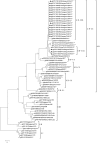Genetic characteristics of the coxsackievirus A24 variant causing outbreaks of acute hemorrhagic conjunctivitis in Jiangsu, China, 2010
- PMID: 24475191
- PMCID: PMC3901726
- DOI: 10.1371/journal.pone.0086883
Genetic characteristics of the coxsackievirus A24 variant causing outbreaks of acute hemorrhagic conjunctivitis in Jiangsu, China, 2010
Abstract
During September 2010, an outbreak of acute hemorrhagic conjunctivitis reemerged in Jiangsu, three years after the nationwide epidemic in China in 2007. In total, 2409 cases were reported, 2118 of which were reported in September; 79.8% of those affected were students or teachers, with a median age of 16 years. To identify and demonstrate the genetic characteristics of the etiological agent, 52 conjunctival swabs were randomly collected from four different cities. After detection and isolation, 43 patients were positive for coxsackievirus A24 variant according to PCR and 20 according to culture isolation. Neither adenovirus nor EV70 was detected. A phylogenetic study of the complete 3Cpro and VP1 regions showed that the Jiangsu isolates clustered into a new lineage, GIV-C5, with two uniform amino-acid mutations that distinguished them from all previous strains. Another new cluster, GIV-C4, formed by Indian isolates from 2007 and Brazilian isolates from 2009, was also identified in this study. Interestingly, our isolates shared greatest homology with the GIV-C4 strains, not with the isolates that were responsible for the nationwide acute hemorrhagic conjunctivitis epidemic in China in 2007. Although all our isolates were closely related, they could be differentiated into two subclusters within GIV-C5. In conclusion, our study suggests that a new cluster of coxsackievirus A24 variant that had already evolved into diverse strains was associated with the acute hemorrhagic conjunctivitis outbreaks in Jiangsu in September 2010. These viruses might have originated from the virus isolated in India in 2007, rather than from the epidemic strains isolated in China in 2007.
Conflict of interest statement
Figures



References
-
- Mirkovic RR, Schmidt NJ, Yin-Murphy M, Melnick JL (1974) Enterovirus etiology of the 1970 Singapore epidemic of acute conjunctivitis. Intervirology 4: 119–127. - PubMed
-
- Chang CH, Sheu MM, Lin KH, Chen CW (2001) Hemorrhagic viral keratoconjunctivitis in Taiwan caused by adenovirus types 19 and 37: applicability of polymerase chain reaction-restriction fragment length polymorphism in detecting adenovirus genotypes. Cornea 20: 295–300. - PubMed
-
- Mu GF (1989) [An etiological study of acute hemorrhagic conjunctivitis in Beijing area in 1984]. Zhonghua Yan Ke Za Zhi 25: 20–22. - PubMed
-
- Wu D, Ke CW, Mo YL, Sun LM, Li H, et al. (2008) Multiple outbreaks of acute hemorrhagic conjunctivitis due to a variant of coxsackievirus A24: Guangdong, China, 2007. J Med Virol 80: 1762–1768. - PubMed
Publication types
MeSH terms
Substances
Associated data
- Actions
- Actions
- Actions
- Actions
- Actions
- Actions
- Actions
- Actions
- Actions
- Actions
- Actions
- Actions
- Actions
- Actions
- Actions
- Actions
- Actions
- Actions
- Actions
- Actions
- Actions
- Actions
- Actions
- Actions
- Actions
- Actions
- Actions
- Actions
- Actions
- Actions
- Actions
- Actions
- Actions
- Actions
- Actions
- Actions
- Actions
- Actions
- Actions
- Actions
- Actions
- Actions
- Actions
- Actions
- Actions
- Actions
- Actions
- Actions
- Actions
- Actions
- Actions
- Actions
- Actions
- Actions
- Actions
- Actions
- Actions
- Actions
- Actions
- Actions
- Actions
- Actions
- Actions
- Actions
- Actions
- Actions
- Actions
- Actions
- Actions
- Actions
- Actions
- Actions
- Actions
- Actions
- Actions
- Actions
- Actions
- Actions
- Actions
- Actions
- Actions
- Actions
- Actions
- Actions
- Actions
- Actions
- Actions
- Actions
- Actions
- Actions
- Actions
- Actions
- Actions
- Actions
- Actions
- Actions
- Actions
- Actions
- Actions
- Actions
- Actions
- Actions
- Actions
- Actions
- Actions
- Actions
- Actions
- Actions
- Actions
- Actions
- Actions
- Actions
- Actions
- Actions
- Actions
- Actions
- Actions
- Actions
- Actions
- Actions
- Actions
- Actions
- Actions
- Actions
- Actions
- Actions
- Actions
- Actions
- Actions
- Actions
- Actions
- Actions
- Actions
- Actions
- Actions
- Actions
- Actions
- Actions
- Actions
- Actions
LinkOut - more resources
Full Text Sources
Other Literature Sources
Miscellaneous

